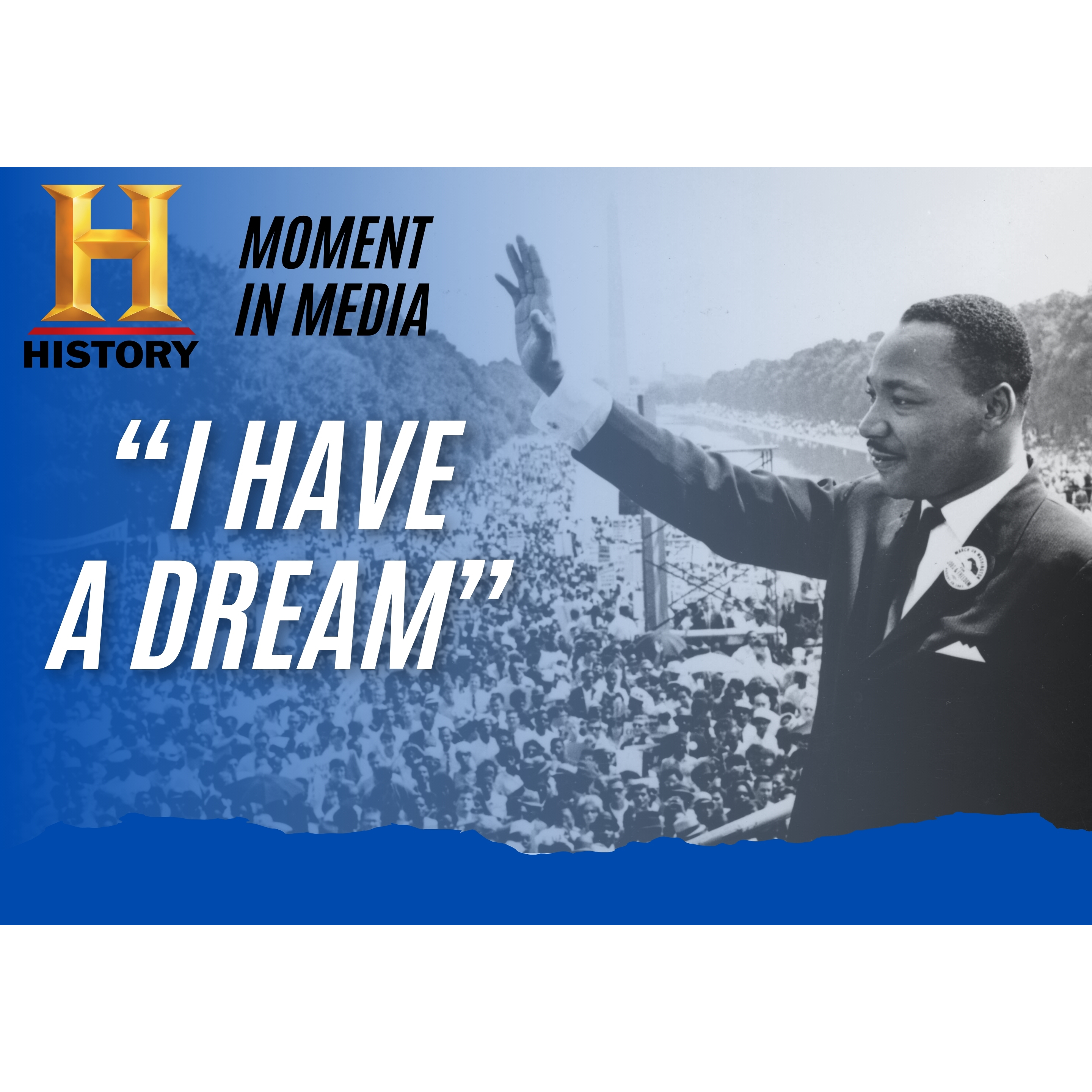HISTORY's Moment in Media: Dr. Martin Luther King Jr's "I Have a Dream" Speech

Organizers hoped to attract 100,000 spectators, and commentators were skeptical even that many would show up. But in the end, nearly 250,000 people gathered at the National Mall in Washington, D.C., to witness an event that was broadcast on all three national television networks and also carried live from 9 a.m. to midnight on the small group of radio stations then called the Educational Radio Network, the forerunner of today's National Public Radio.
On August 28, 1963, the March on Washington for Jobs and Freedom brought attention to the United States capital, where a huge range of civil rights groups -- including Dr. Martin Luther King Jr's Southern Christian Leadership Conference, the NAACP, the National Urban League, the youth-led Student Nonviolent Coordinating Committee -- organized a day of rallies, performances and speeches that went off without a hitch. The protest was beamed into living rooms across the country, driving home the need for federal civil rights legislation.
Its capstone was King's "I Have a Dream" speech, delivered 61 years ago this month.
It wasn't the first mass march on Washington for equality. In 1941, the threat of one from the Brotherhood of Sleeping Car Porters union resulted in President Franklin D. Roosevelt issuing an executive order that created the Fair Employment Practices Commission, which looked into charges that Black Americans were being systematically excluded from jobs in the rapidly growing defense industry. At the 1957 Prayer Pilgrimage for Freedom, protesters rallied at the Lincoln Memorial to mark the third anniversary of the U.S. Supreme Court's ruling of Brown v. Board of Education, which integrated public schools. And at the 1958 Youth March for Integrated Schools, demonstrators called for a more effective implementation of the Brown ruling.
But 1963 marked the 100th anniversary of the Emancipation Proclamation. Segregation, disenfranchisement, underemployment, and unemployment were still facts of life for Black Americans. Plans for the big march were underway as early as May 1962. And this time, the program was also arranged with media attention in mind.
Television was still a young medium, but some 91 percent of American households owned a set by 1963, according to Nielsen. March leaders were determined to present a positive image. Protesters were permitted to carry signs with preapproved messages and themes. Organizers worked to ensure "no negativity, except around the issues they all agreed on," as one historian put it.
Despite warnings from the FBI to stay away, countless celebrities, Black and white, lent their names and influence to the cause. Ossie Davis and Ruby Dee served as emcees. The day opened with performances from Joan Baez and Peter, Paul, and Mary. Lena Horne took the podium to shout one word: "Freedom!" Mahalia Jackson sang the national anthem. Marchers included Nina Simone, Burt Lancaster, Harry Belafonte, Sidney Poitier, Charlton Heston, Paul Newman and Joanne Woodward. Judy Garland, who had to stay in California for her variety show, served on the planning committee.
"My talent was the weapon, the power, the way for me to fight," said Sammy Davis Jr., who was there. "I think it was the most American day in the history of our country, save for perhaps the Battle of Bunker Hill or maybe the signing of the Declaration of Independence."
There were numerous speakers on the lineup that day. Union leaders, religious leaders, and civil rights activists, like Walter Reuther, president of the United Auto Workers. Civil rights leaders present that day included A. Philip Randolph, the president of the Brotherhood of Sleeping Car Porters union who had threatened the 1941 march; and student leader John Lewis, who went on to become the legendary Georgia Congressman. Rabbi Joachim Prinz, president of the American Jewish Congress and Holocaust survivor, spoke right before King. "A great people who had created a great civilization had become a nation of silent onlookers," he said. "America must not become a nation of onlookers. America must not remain silent."
But it was King's oration that has gone down in history. Filled with references not only to the Emancipation Proclamation but also to the Declaration of Independence, the Constitution, the Gettysburg Address, and the Bible, he masterfully moved the crowd gathered in Washington and sent a powerful message to Americans across the country.
In his speech, which was more than 17 minutes long, King sketched the ongoing mistreatment of the Black Americans who'd arrived in the country as enslaved people. But he also pivoted forward: "We refuse to believe that the bank of justice is bankrupt," he said. "We refuse to believe that there are insufficient funds in the great vaults of opportunity of this nation."
He offered a positive vision. "Now is the time to make real the promises of democracy," he said. And then King spoke of his dream: "I have a dream that one day this nation will rise up and live out the true meaning of its creed: We hold these truths to be self-evident, that all men are created equal."
Thanks in no small part to King and that August march, Congress went on to pass the Civil Rights Act of 1964 and the Voting Rights Act of 1965. Still, at that time, fewer than half of all Americans held a positive view of King. But by the time the Martin Luther King Jr. Memorial was dedicated in August 2011, a short walk from where he delivered those famous lines, 94 percent of Americans did.
Click the social buttons to share this story with colleagues and friends.
The opinions expressed here are the author's views and do not necessarily represent the views of MediaVillage.org/MyersBizNet.

